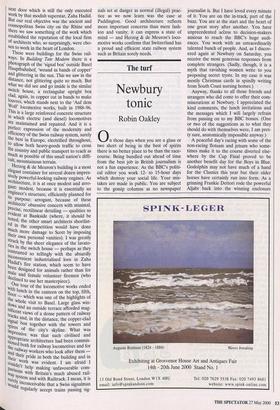Not motoring
Swiss elegance
Gavin Stamp
Icould not have gone to the now-notori- ous opening party for the Tate Modern had I been invited (which I wasn't) as I was away that day with the Twentieth Century Society in Basel — as it happens, the home of Herzog & de Meuron, the architects of the conversion of Bankside Power Station into the new gallery. With me was Alan Powers, who wrote here about the story of this transformation on 13 May (and who wasn't invited to the party either, although he, like me, played a role in ensuring the survival of Sir Giles Gilbert Scott's 'cathe- dral of power'). For Alan, 'it would be hard to say where [Herzog & de Meuron] have put a foot wrong'. As for me, as I have been banging on about the merits of Bank- side since 1979 (although it was Marcus Binney who first proposed the use of Scott's industrial masterpiece as a museum, as far back as 1980), I cannot admire some aspects of the conversion. I lament the loss of the ziggurat profile of the building when seen from across the Thames by the elimination of the 'haunch- es' of the great central campanile-chimneY. This profile meant much to Scott, as did symmetry. I therefore also find it painful that the new glass box which sits on the roof of Bankside is not symmetrically dis- posed in relation to the brick mass below. We learn from an interview in the new book about the building published by the Tate, Building Tate Modern (which alsc) contains an historical account of Scott's building), that for Jacques Herzog 'tile symmetry of Scott's building is something we had to deal with which I think we all fellt sometimes was a bit too heavy'. If so, this 15 not a problem which worried, say, Wren, e'r even Mies or Gropius, let alone God (t° judge by the way He designed human beings). Never mind: I am thrilled that most of Scott's supreme industrial master- piece has been retained for a new and hell' eficial public use when it could easily have been demolished. Hooray! But I was intending to write about Basel' We were on a 'Three Countries Tour' as We forayed out of Switzerland to see Le 03r... busier's supreme and wonderful master' piece, the pilgrimage church of Mitre Dame du Haut at Ronchamp (which is in France),: and just over the border into Germany to see the Vitra Design Museum by Frsi ail llY Gehry, together with the profoundly ., (and already redundant) new fire static' next door which is still the only executed work by that modish superstar, Zaha Hadid. But our real objective was the ancient and cosmopolitan Swiss city on the Rhine and there we saw something of the work which established the reputation of the local firm of architects who, so surprisingly, were cho- sen to work in the heart of London.
These were buildings for the Swiss rail- ways. In Building Tate Modern there is a photograph of the 'signal box' outside Basel Hauptbahnhof, 'wound in bands of copper' and glittering in the sun. This we saw in the distance, not glittering quite so much. But what we did see and go inside is the similar switch house, a rectangular upright box clad, again, in copper cut in bands to make louvres, which stands next to the `Auf dem Wolf' locomotive works, built in 1988-96. This is a large reinforced concrete structure in which electric (and diesel) locomotives are maintained and repaired. And it is a Perfect expression of the modernity and efficiency of the Swiss railway system, surely the best in Europe, electrified throughout, to allow both heavy-goods traffic to cross the country and public transport to reach as much as possible of this small nation's diffi- cult, mountainous terrain. Herzog & de Meuron's building is a most elegant container for several dozen impres- sively powerful-looking railway engines. As architecture, it is at once modest and arro- gant modest, because it is essentially an Its engineer's structure, efficiently planned for purpose; arrogant, because of these architects' obsessive concern with minimal, Precise, rectilinear detailing — qualities so evident at Bankside (where, it should be noted, the other smart architects shortlist- ed in the competition would have done much more damage to Scott by imposing their own personal vanities). I was greatly struck by the sheer elegance of the lavato- ries in the switch house — perhaps as they contrasted so tellingly with the absurdly inconvenient industrialised loos in Zaha -ladid's fire station, which seem to have been designed for animals rather than for Tale and female volunteer firemen (who declined to use her masterpiece). Our tour of the locomotive works ended . lunch in the canteen on the top, fifth, tk°13r — which was one of the highlights of the whole visit to Basel. Large glass win- dows and an outside terrace afforded mag- nificent views of a dense pattern of railway tracks and, in the distance, the copper-clad signal box together with the towers and • Pires of the city's skyline. What was impressivewas that such civilised and r°Priate architecture had been commis- ned for railway locomotives and for Lane railway workers who look after them thilAci. their pride in both the building and in coin work was evident. I am afraid I auldret help making unfavourable corn P nh with Britain's much abused rail s;Y system and with Railtrack. I mean, it is relY ', inconceivable that a Swiss signalman Quid regularly accept trains passing sig- nals set at danger as normal (illegal) prac- tice as we now learn was the case- at Paddington. Good architecture reflects more important concerns than mere fash- ion and vanity; it can express a state of mind — and Herzog & de Meuron's loco- motive works confirms that Switzerland has a proud and efficient state railway system such as Britain sorely needs.



































































 Previous page
Previous page